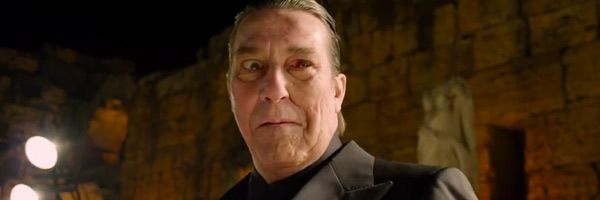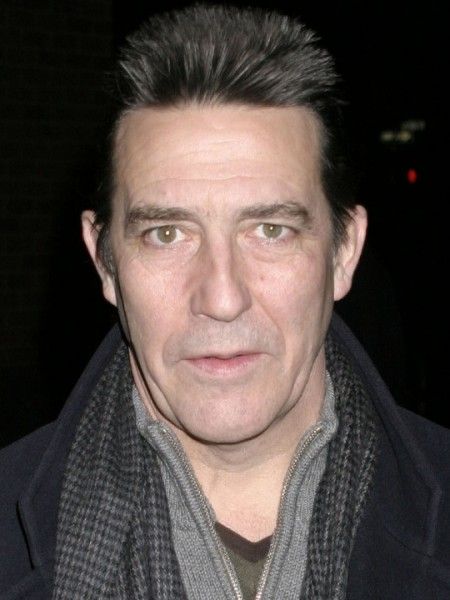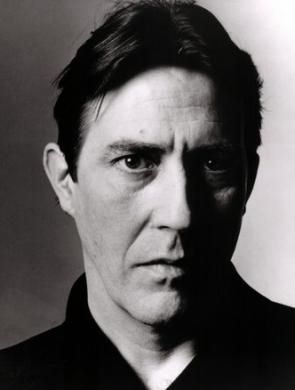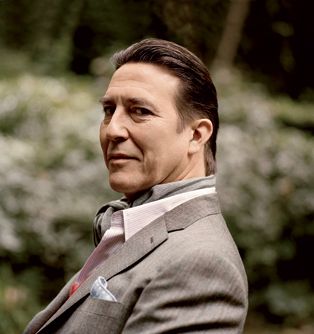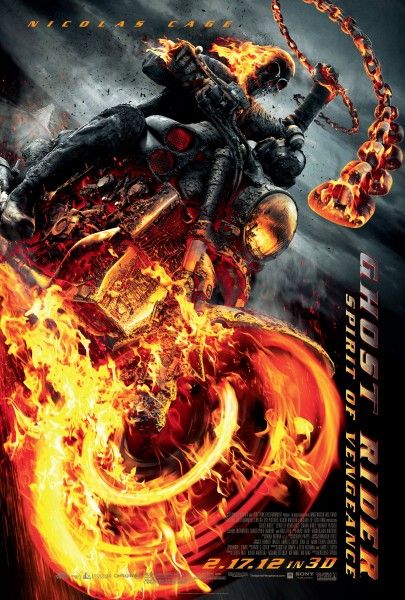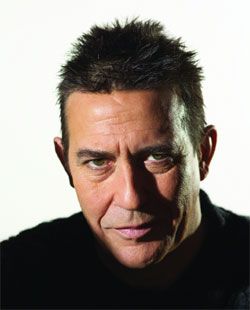While you may not know the name Ciaran Hinds, you've definitely seen his work. That's because over the last few years, Hinds has been great in many high profile projects like Harry Potter and the Deathly Hallows - Part 2 (he played Aberforth Dumbledore), Tinker Tailor Solider Spy, There Will be Blood, Road to Perdition, Munich, HBO's awesome series Rome, and many others. In fact, when I first heard Hinds had been cast as the devil in Ghost Rider Spirit of Vengeance, he became one of the reasons why I had such high hopes for the sequel.
Anyway, last year I got to visit the set of the Ghost Rider sequel while the production was filming in Romania. Shortly before going to set I participated in a group interview with Hinds. He talked about how he got cast, what it's like to play the devil, working for Neveldine/Taylor, what it's like to work alongside Idris Elba and Nicolas Cage, and so much more. Hit the jump to read or listen to the interview.
Before going any further, if you haven't seen the new trailer, I'd watch that first. Here's the synopsis:
Nicolas Cage returns as Johnny Blaze in Ghost Rider Spirit of Vengeance. In the successor to Ghost Rider, Johnny - still struggling with his curse as the devil's bounty hunter - is hiding out in a remote part of Eastern Europe when he is recruited by a secret sect of the church to save a young boy (Fergus Riordan) from the devil (Ciaran Hinds). At first, Johnny is reluctant to embrace the power of the Ghost Rider, but it is the only way to protect the boy - and possibly rid himself of his curse forever. Directed by Mark Neveldine and Brian Taylor.
As usual, I'm offering you two ways to get the interview: you can either click here for the audio, or the full transcript is below. Ghost Rider Spirit of Vengeance opens February 17.
Question: Do you automatically sign on a project when you’re going to be playing the Devil?
Ciaran Hinds: That would seem to be the case, having only been offered twice to play the Devil and I’ve said yes both times. [laughs] It’s funny, I don’t know, this came out of the blue for me really, ‘cause I didn’t know Brian [Taylor] and Mark [Neveldine], the directors, didn’t know them at all, and I didn’t know the genre. And obviously I have an agent who’s on the ball and who said, “There’s this project that’s going and it might be fun and it might be very interesting. Do you want to play the Devil?” Which I didn’t know it was the Devil -- he was called “Rourke” when I read it, and then bit by bit you read the script and you understand that it’s someone else. But when I was asked to do it, I was actually playing a Vatican priest who was giving lectures on exorcism, so I thought I had to go there as well and find out what it was talking about.
Could you also talk about the fact that Neveldine and Taylor are known for their wild cinematography, the way they are on sets as compared to other directors you’ve worked with -- can you talk about working with them?
Hinds: Yeah, I was filming something in London, and a couple of guys came in to do some EPK afterwards, and they’d seen something that was on the net and they said, “I believe you’re going to work for Mark Neveldine and Brian Taylor,” and I said, “Yeah, they’re directing Ghost Rider. And they said, “They’re crazy guys!” [laughs] And I said, “What do you mean?” And he said, “Well, they’re just kind of wild and bold and brave.” And I said, “What do you mean?” Then they started telling this story about Mark, as they’re both directors of photography as well, which I didn’t know, but Mark sometimes just takes a camera and he goes on blades, and hangs onto the backs of lorries...so I’m just thinking, “I can’t be doing this at my age,” ‘cause I didn’t know really what it entailed. But what I have found out, when I met them, is that they’re fantastic. They’re both so sharp, so energetic, they know what they’re doing, they know what they want to play with, and they’re so vital. You know what I mean? They’re actually full of life, and how they stitch all this together, I don’t know. That’s their business. But it’s been a very energetic ride. And also as a…you’re supposed to be representing some form of Mephistopheles, whatever that entails, and they’ve been fantastic just at the level at which you should come in on it. And they’re actually really good. I’d trust them to direct me in almost anything, never mind the genre, because they just have a mind for what is required in the fabric of the whole thing.
They mentioned that Idris [Elba] rides a motorcycle and we know that obviously Nic [Cage] rides a motorcycle, but as the Devil do you get to ride a motorcycle or do anything like that?
Hinds: Funnily enough, I’m just walking the planet. There’s a scene where I go into a rent-a-car and that doesn’t work out [laughs]. Well, it was the other guy’s fault, you know? But there you go. So basically, he just ends up in these places, you know what I mean? The first time you see him, he’s coming off a train, public transport. Goes to rent a car, it doesn’t work out, but then the next time you find him, he’s on a scene of utter devastation. I suppose that’s the way it works. Self-transport.
When you’re playing a character like the Devil, somebody that’s pure evil, how do you approach that from an acting standpoint? Like, do you have the motivation to just play pure evil or do you just have fun with it?
Hinds: I suppose you have fun with it, but then, as Brian rightly pointed out, ‘cause he does that thing about what’s inside people -- there’s the Devil in all of us, or the light side in all of us, or the generosity that we all have. What side comes out at different times? I suppose that’s what the Devil is. But he’s been very careful, because the first time when you see a very spare script, not to try and lay it on too thick, because it’s there. But at the same time you have to give this essence of bile or something, of frustration and kind of “don’t fuck with me. I will be kind to you, but don’t fuck with me.” And at the same time, you can over-embellish stuff and it can become a bit parodic or pantomimic. And a couple of times suddenly I sort of felt myself going over that way, and Brian said, he just said, “Pull it back a little. Just get pissed off.” Rather than go, “I want to eat you all up,” just get pissed off. But I think the way the character is placed in it, he’s there and he’s gone, he’s there and he’s gone, and it’s a race against time to see if he can transport his dark soul into the child that he himself has created as almost his perfect time capsule to be continually on Earth. That’s the race for him.
In some movies the Devil is pure evil. What’s the level of your Devil from one to 10?
Hinds: I think he’s about three and a half [laughs]. He’s not a very good Devil, ‘cause if he were, everybody would be in tatters, you know what I mean? But at the same time, one on one you only actually see him, you see him use his powers twice. Most of the time it’s a race against time for him. He’s a devil on his way out. That’s what it is. His body is giving up on him and that’s why he’s trying to retain a sense of ease and control and having everything happen. Meanwhile, his body -- his face is starting to fall off him. You know, it’s sort of the human weakness that he’s placed himself into the vessel of a human being and it’s giving up on him, you know, which also pisses him off. So for him, with the whole shell disintegrating, the idea is that he has to find a new receptacle in which he can regenerate and push on to further adventures. That’s the journey. And so for him, he wants to remain calm in the situation. But bit by bit, he comes to the moment where there’s an hour of prophecy that you have to be in; it’s a race against time.
So are you spending most of the movie in prosthetics? More than usual?
Hinds: Yeah. But it changes. There’s about four different stages.
Is this the most prosthetics you’ve ever done for a movie?
Hinds: I’ve only done prosthetics once before, which was last year for Harry Potter, and so I suppose the idea of sitting in the chair for two hours is kind of strange initially. You get used to it over time, but what is fantastic is watching great artists. Your own face disappears and you just watch them not only apply, and then blend in, and then map the canvas and then paint over it. The finesse and the detail of watching other people work, it sort of keeps you calm inside the two hours it takes.
You mentioned Mephistopheles and Peter Fonda actually played Mephistopheles in the first Ghost Rider. Are you another version of that character? Is there any connection at all?
Hinds: I don’t think there’s any connection at all, because they’ve also got two different names. But then the Devil has many different names anyway, you know?
You mentioned looking for a new vessel, so I was wondering if you were a new vessel from the first film...
Hinds: The boys haven’t alluded to it at all, and I think Brian and Mark had decided that we were going to take this and put our stamp on it. We’re not following a track that’s been laid down. We’re taking the story and we’re beginning with what we want to do, therefore they don’t feel, I don’t think, obliged to follow what’s been set down before. They have their own energy, their own creative juices, wouldn’t dictate to them, I imagine. Except there is a connection, that the producers were on the first one as well, so maybe they have an overall rider on how it should be done.
Is that freeing for you as an actor, not to have to come in and portray what has been done before?
Hinds: I suppose it is, but then again it depends on what the gig is. How would they continue that? If Mr. Peter Fonda's not available, then are they going to make me prosthetically into Peter Fonda, am I going to mimic Peter Fonda's voice...that doesn't seem to make sense. Just get Peter Fonda. [laughs] So then you bring in whatever you have to offer. And it does free you up, without having to follow steps just bit by bit. You're much freer, that's for sure.
Will we see you in your true form? As sort of the horned devil...
Hinds: No. No. Because that's the -- the Devil's in the human form, which is slowly collapsing. He's quite a natty dresser, or he thinks he is. [laughs]
What was it like working in scenes with Nic?
Hinds: It's very funny, because the scenes with Nic, basically, I just see something coming and have the lights punched out of me. That's scene one. Then I come to, and have a couple of words with him, and then I go on the run. And then the next time I meet him, he just picks me up and throws me way up into the sky, and then lashes me back down into the inferno that's called Hell. That's my work with Nic. I don't think he tolerates devils [laughs]. I don't think he likes to objectify them, talk to them, rationalize with them, I think he's on a mission to get the hell out of here. But just to be working with him, he is one of the most unique actors in the world. Absolutely unique. His style, his rage, his commitment, his passion, his imagination. But then the films I've adored like Adaptation, which has just an extraordinary performance. Truly extraordinary. And then is it Matchstick Men? Brilliant, absolutely immediate and vital. Just to be around him and watch him go.
Are we going to see the other Nic Cage, the sort of mad one?
Hinds: Yeah, you feel his energy. You feel this that’s just so of focused right in the moment. There’s no pussyfooting around wondering where we’re going with it. It’s clean.
Did you watch the first film or read any of the comics...?
Hinds: No, I haven't. I'm not a comic person at all. It never reached me in the north of Ireland, in the '60s and '70s growing up. We used to get stupid comics like "The Topper" and "The Beezer,” things like that. But this whole big American imagery of darkness and superheroes, I never really got into. Everybody said, “But you’ve never heard of Ghost Rider?” and I said, “Sorry, no. I’m a bit remedial.” It's fun because it's something you go, like, “What is this stuff?” And yet you understand it's allusions to myth and the light and the dark that’s around us all the time.
What do you think of the American superhero film and how that genre has really taken over?
Hinds: It really has, hasn't it? Of course, Chris Nolan has revitalized Batman and then Iron Man kicked in in a very big way. The first one was fantastic, although they were never sure. “Well here's a project, let's do it as best we can, it might take off.” But then suddenly you read about Green Hornet, Green Lantern, um, How Green Was My Valley [laughs], I don't know, I haven't read all these, but I think I’m going to look forward to seeing them.
What's the stuntwork been like for you?
Hinds: Stuntwork…once, I’ve really only done one thing which is take a punch and transport myself into the air onto a mat. I suppose the way the guys shoot, they just get this sock that disappears. Apart from a few bruised ribs, I'm fine. But tomorrow I'm being suspended on wires, which is not something I've done. But they take you up and then I think they start flying you as if you're doing that stuff, you're leaving the Earth and you're flying out of the zone. So I have yet to find out. I'm going to find out within the next 24 hours.
Are you nervous?
Hinds: I'm not nervous, but I'm not particularly looking forward to it [laughs]. 'Cause it's gonna hurt, you know? There's no way out. People are gonna pull you on wires and when you reach a certain age, you're like, “Oh, don't do that! Agghhhhhhh!” And then they do it again, and again. And then you go, “Oh, stop, please,” and they don't. They have to get the shot.
The first movie was very CG-based, and I get the impression they're doing a lot more on-set, a lot more practical. Is there some CG which you kind of have to imagine is there?
Hinds: There is, because there's green screen and they've got inserts, and of course you can't have, “C’mon, Nic, show us your flaming skull there, you know, pull that one out.” So there will be that. And there's other stuff that they also need to enhance the world. But they've done a lot of stuff location-wise, trying to pick up the reality of where they are before the other supernatural stuff comes in. So there will be obviously some CGI, but I suppose the game now is to mix it so that you're not quite sure which is and which isn't, and to shoot it for real, and see if you get away with some effects on the ground that were added in.
Do they show you anything of what you're going to be seeing later?
Hinds: No, but actually the visual effects, Alex showed me last night, “We’ve printed this up. We've made this up to show you what we're going to try and do with you,” which is just going in a certain direction. But the whole arc and storyline and how it's gonna look and stuff like that...no idea, really.
I could be wrong, but you guys are shooting this in 3D?
Hinds: No, it's shot conventionally and they'll do it in post. I don’t know if you know how they shoot in 3D, they do things and then if you’ve got to add stuff, they put a ball in and something else goes round, so they can add in 3D. They shoot it empty, I think. The actors still know they’re going to exist in a 3D universe.
Knowing that this movie will be released in 3D, has it changed the way you're acting at all or changed any part of your performance?
Hinds: No, certainly not, because we act in 3D anyway. The camera makes it 2D, because of the flat screen, but we are acting in 3D, really. Forward, backward. Then they project whatever, 3D, they're gonna have.
I've just heard from some people that when you know you're gonna do 3D, your movements might be a little bit more...
Hinds: More pronounced?
Yeah, that kind of stuff, but I could be wrong.
Hinds: I suppose...I don't know how it works, really. I have seen a couple of things in 3D, and some of the things come out at you, but I suppose -- does anybody know? [laughs] Volunteers? But I know what you mean -- if you're gonna move forward, do you move an extra pace forward so that you come up further out of the screen?
It’s a direction thing whether or not they tell you they want you to do that.
Hinds: Yeah, “For God’s sake, stop taking those mimsy steps!” for example. [laughs]
The other thing with 3D is that a lot of the times, shots go on longer. Have you found that some of the shots have gone on a little longer...?
Hinds: Sometimes you don't know when they're gonna cut. You say, “Well, everything in the scene’s gone through, but they're still moving this camera around.” “Well, just keep going.” “But I'm running out of stuff.” “Invent something, I don't know.” But it's quite funny, sometimes they just say, “Cut,” and you'll say, “Well, that was mad,” and they'll say, “Yeah, but was it any good? Probably not, so we'll do it again.” But it's kind of fun to work that way, it's always just, it's a bit playing, but while you're playing, you're very committed to what you're doing. I mean, there are some emotional contexts that are going on in the storyline, but also it's about enjoying the emotions of it, I think. The style is kind of full-on. The last time I met you, we were talking about The Eclipse, which is a much more personal thing, where the camera kind of observes you a bit, but this is going out to meet it in a different way.
You're also here in Bucharest, Romania, could you talk about being here and filming on location and have you enjoyed the city?
Hinds: Yeah, I've just got to see it the last day because I only joined the team after the new year, and they've been here since early November. My journey was scheduled to start in the new year, so I literally got here on a Wednesday, worked five days, and then I went to Turkey, which was extraordinary. The locations that they chose in Turkey were fantastic. And then just got back here four days back and then started working again, so I've literally just seen it in the last three days. Have you been down to the Old Town?
We only all got here yesterday.
Hinds: Go to the Old Town if you get a chance, because it's sort of being reconstructed as we're talking, so they're digging up all these cobble roads. But you can bring horses and carts down, it's got that really old feeling to it, and yet it also seems to be being rebuilt creatively and individually, and not just being made into one big mound, you know what I mean? It’s only about 10 minutes from here if you get a chance. We went to the Palace, Ceausescu's gaffe [laughs] That takes your breath away. What was the idea of this? If you left something behind, how would you remember where you put it? The size of it inside, it's like 14 stories high, but it's a working place now. This is a relic of this time of horror, but they said because so many people worked in there, there were 20,000 people working on it for five years inside, but also to make all the fabrics, the wood, the marble, all that stuff, in the end there were almost a million people working to create this over a period of five years. And some of it's beautiful, quite breathtaking. In the tour, they only take you down the first floor and a half, but all the rest they’ve used for working, because, as they said, it was in a way built for the people, so we should use this. And it is their Parliament, but it's also used for charity events and stuff. But it is, it's a breathtaking scale. The second biggest building in the world after the Pentagon, apparently.
The second biggest state building.
Hinds: The biggest one in Europe?
They knocked down fifteen blocks and just started building it.
Hinds: Yeah, they cleared everybody out. That’s why there are a lot of dogs around, as well.
That’s why there are a lot of dogs around?
Hinds: Because they cleared out whole areas to rebuild this and they said, “Get them out.” They were relocated and all these pets were just left and now they built these apartments. They used to have houses.
You mentioned being shown some of the pre-vis for what you’re going to do tomorrow. Do you find that very helpful with a film like this to be able to be shown, “Hey this is how we’re going to try to do this,” and then you get a better idea than if you were just using your imagination?
Hinds: Yes, it does, because in the end, you can be out of control, I imagine, just having a try-out with your harnesses. You go like, “Well, which direction am I supposed to go?” because you don’t have full control. I’m not the strongest of guys and I go, “How do you get this when you’re not on the Earth?” What you can see is, “Oh, I should be heading this way just at the time to meet the camera,” because it is about choreography and timing and movement for them to capture the image. If you know how they see it, rather than being on a harness and have them saying, “No, that’s not it!” “Well, what is it?” Then you can visualize it and then you can, in a way, if you can get yourself into the shape that’s required to catch the moment.
Is there more action in this than John Carter or some of the other things you’ve been doing, because you’re doing a lot of big action movies lately.
Hinds: Yeah. We’ve dug deep. We wielded some ancient antique-style swords in John Carter, because there’s a couple of pitched battles and stuff, because we were playing sort of the older royalty, or Jeddaks, who usually got the other people to do all that stuff. “Okay, you fight for us and go and sort out those white apes, or whatever.” Hand-on-hand, this hasn’t been too much; it’s mostly been a journey. The scenes that I have are a journey just going from here to there and trying to get this idiot Carrigan, who’s my right hand man, who’s absolutely useless, to get ahold of the boy.
Could you talk about what the last year or two have been like for you? As some people just mentioned, you’ve been in a lot of high profile gigs over the last year or two. Even if it’s smaller parts, as you mentioned, Harry Potter, John Carter, The Rite, this.
Hinds: Sometimes it’s out of our control, in a way. It depends, the powers that be or a matter of who sees your work or who places it at a certain time or what they feel they might use you for, why you, you never really know. That’s an artistic choice of some; there has to be a reason of whether you look right or you bring the emotional or intellectual baggage of what’s required for the storytelling. For me, it’s not something I’ve aspired to say, “I’m going to be working in Hollywood.” In fact, most of the work that I have done for the American Hollywood things have not been in Hollywood. The studios are going out in Europe or around the place working. It’s been very exciting because the scale of it is very different from what we’re used to working on in England or in Ireland. It’s just the scale of it. And then you realize that the preparation and the planning of this small army of people trying to head to the single aim of creating a work that’s going to excite people is very risky. Of course, the odds are that it’s not going to work out because there are too many possibilities of it going wrong. But the joy of just being involved in something, of being part of a big process, just as a human being, it’s nice to be part of people who are in the same enterprise, heading for the same goal, rather than, “Oh this is all about me and my role. The story’s about me.” I quite enjoy more teamwork and offering something up into the mix.
Is it easier when there are two directors rather than one?
Hinds: I’m sure you’ve asked these questions. You think, “That’s insane!” “No, I don’t want to do it like that.” “Don’t shoot it like that!” “No, I want to do this.” But these guys, when you see them, they say, “Do you want to do it?” “No, I’ve got that.” “Actually, I’ve just thought of something. Give me a moment, I want to shoot something, pick something up here.” You can just see this genuine collaboration and understanding of their two minds, which is usually, if there are two of you in control it can sometimes be a battle, not particularly for who controls, but just conflict. Conflict, they think, sometimes produces results, but more often than not it produces confusion at the level of everybody on the same track. To me, they complement each other brilliantly.
Have you been to Comic-Con before and are you prepared to go next summer?
Hinds: No, I’ve never been to Comic-Con before.
You’ve heard of it though?
Hinds: I’ve just heard about it recently because I think Andy Fickman, who did Race to Witch Mountain, he’s a big Comic-Con kind of guy, I think. He said it’s great fun. I’ve seen shots of it. It seems insane. [laughs] It just seems insane, but then that’s fun.
If you want to feel like “The Rolling Stones” just go do Hall H. It’s a huge mob of people.
Hinds: You go out like, “And here’s the Devil,” and everybody goes like, “Whee!” [laughs]
That’s exactly what will happen. You’ll have to practice some Devil things to do it.
Hinds: I’ll have to bring a whole kit. A whole devil magic kit.
Maybe they’ll give you in a harness.
Hinds: Oh, no, no, no. I’ve got a pair of shears for that harness once I’m done. [laughs]
Before we run out of time, could you just tell us what you look like in the movie? Are you wearing a costume throughout most of the film?
Hinds: It reminds me of the kind of gear my Uncle Jack used to wear, like a dapper man who likes to present himself very well, as opposed to everybody else who’s running around in practical military gear. He finds himself above the Earth, when in fact he’s below it, but the idea is he feels above it. So, he’s very smart, but his face is collapsing. So what you do is, you see this man and say, “There’s something wrong with his face.” In the first scene there’s a little bit of stretching and in the next scene it’s gone a bit further and then something pops in his eye and then his face starts to get more and more distorted just in about four or five different stages. That’s where the prosthetics come in, when there’s a moment to change it. I suppose the effects they can use a little bit of movement so you can actually see the face at times just shift, but they’re actually laying it on at different stages.
So you’re wearing a suit?
Hinds: A suit, yeah. A couple of suits, actually.
How old is the vessel that you’re occupying?
Hinds: About as old as me. [laughs] But, in slightly worse shape. Just slightly. I suppose at my age, I’m in my 50s, but I suppose it’s just the idea that the interior shell is giving in and the manifestation is a visual thing in his face. I suppose that comes from the book itself, from the story and the pictures that we saw in the Ghost Rider comics. You see these faces or changes in people when they’ve been touched by things and that’s just sort of a great visual imagination and they’re trying to realize it.
Have they showed you images from the comics?
Hinds: No, they didn’t. They just said, “This is what we’re going to do to you.” They didn’t say if I had any objections. [laughs] But there you go.
-
For more on Ghost Rider Spirit of Vengeance:
Nicolas Cage Ghost Rider Spirit of Vengeance On-Set Interview
Idris Elba Ghost Rider Spirit of Vengeance On-Set Interview
Director Brian Taylor Ghost Rider Spirit of Vengeance On-Set Interview
Violante Placido Ghost Rider Spirit of Vengeance On-Set Interview
Fergus Riordan Ghost Rider Spirit of Vengeance On-Set Interview

